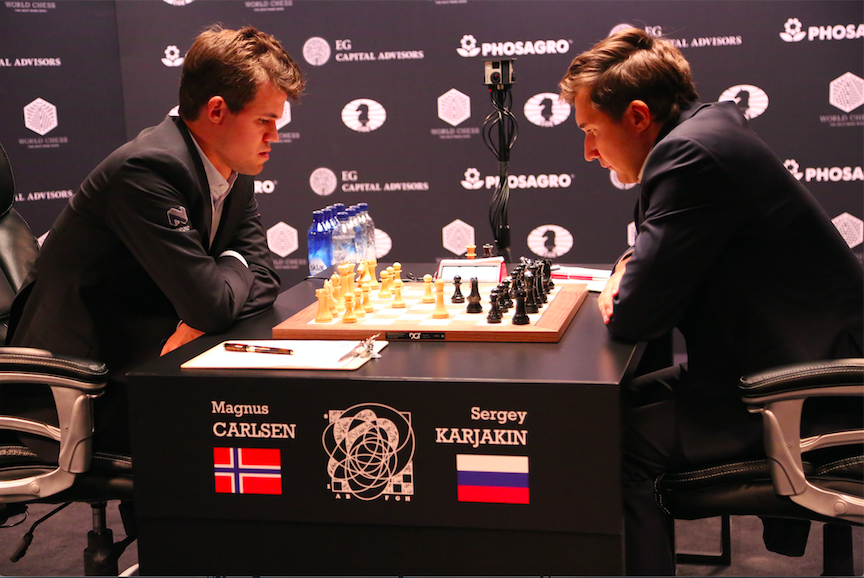Modern Love for a Medieval Game
Magnus Carlsen of Norway and Sergey Karjakin of Russia dueled in an intense game of chess at the World Chess Championship.
November 17, 2016
When most people recall their experiences with the game of chess, they probably think of a rainy day in elementary school or of many failed attempts at beating a sibling or a parent. Some may think of the name Bobby Fischer, the infamous American chess player who drew as much attention to himself as he did the game. But for certain individuals, the game of chess is their livelihood, and their purpose in life is to be the best.
Reigning world champion Magnus Carlsen of Norway is attempting to defend his title from Sergey Karjakin at this year’s World Chess Championship, which kicked off in the Fulton Market Building Nov. 11 and will continue until Nov. 30 if all 12 games are necessary.
Carlsen has been hailed as possibly the greatest chess player ever. A child prodigy, he became a Grandmaster, the highest possible title attainable in chess, at 13. He soon became the highest-rated player of all time, reaching an eye-popping rating of 2882 in 2014, by which time he was already the chess world champion. For comparison, the 97th percentile of chess ratings in the world is a range of 2000 to 2099, for all ages, according to the U.S. Chess Federation.
Carlsen is, in many ways, the black sheep of a new generation of chess players who use a computer for every purpose imaginable. Most players use the engine to prepare openings by finding possible exploits if their opponents deviate from the top-ranked computer line of moves, and they sometimes even have entire games plotted out on their screens to memorize. Magnus does the exact opposite — he is notorious for not putting too much emphasis on opening preparation at all, preferring to dodge his opponent’s preparation and just play chess.
I liken Carlsen to the tennis player who, in the first set, looks not to 6-0 his opponent and take them out of the game, but rather aims to hold serve, maybe force a tiebreak and prepares to grind out the match, however long it may take.
Once the changeover happens from first to second set, the true magic of watching Magnus play first starts to appear. Like the tennis player who returns every ball and somehow manages to hit a winner right on the line at the end of every rally, Magnus finds the right move at a stunning rate of accuracy. Playing like him is like taking the SAT: everything seems normal for the most part — after all, he does aim for relatively simple positions — but there will be some insidious trick hidden somewhere that is almost inevitably missed. And like a makeshift dam slowly turning into a leaking sieve, the opponent’s defense crumbles away and Magnus emerges victorious.
His opponent, Sergey Karjakin, was equally prodigious as a kid. While Carlsen was the third youngest player to ever become a Grandmaster, Karjakin was the youngest, reaching the rating level of 2500 required to be a Grandmaster at 12. While not as obscenely brilliant as Carlsen, Karjakin, or as the current joke goes, “Draw-jakin” (due to his propensity to tie a lot of games), is a formidable challenger due to a tenacious playing style somewhat reminiscent of Carlsen’s. Though he is also inclined to patiently wait for opponents’ mistakes, he lacks the hyper-technical accuracy that only Carlsen possesses. However, he is extremely well-prepared in the opening, using his computer to plan out his matches as far as he can.
Mainly using his opening preparation to gain subtle advantages in the game going forward, Karjakin is very much capable of outplaying his opponents. He is very resourceful when pushed against the wall: in a recent World Cup final, he was down 0-2 in the best-of-six final against a fellow top-10 player in the world and turned it around to win 6-4. It remains to be seen whether Karjakin can rise to the occasion and push the computer preparation generation even further along, or if Carlsen will defend his title and perhaps usher in a new style of play altogether.
It’s hard to imagine why most people would want to watch other people play chess. I myself was skeptical of the organizers’ attempts to broaden the appeal. When I arrived for round one, I mostly saw faces I recognized from my own tournaments, people who already had the game as an integral part in their lives. When I traipsed by the VIP (read: corporate sponsor) area, people were far more occupied with the open bar than the game going on, which is at least understandable, if a little disappointing, considering entry was $1,500 a head.
By the time I made it into the playing area, about two hours after the game had started, it was virtually empty. The appeal of seeing the most famous chess player in the world sitting at the board had evidently worn off, and most attendees were instead loitering in the lobby viewing area following the moves while visiting Grandmasters made comments. By the time the game had wrapped up, an arduous draw, the only people who remained were press and dignitaries.
I left that day a bit disappointed, but understanding. There’s not much of a live appeal in seeing a game played out where all the action is cerebral. When I came back for round two on Saturday, however, I saw a totally different scene. Whereas on day one there wasn’t much of a crowd to enter, on day two, I saw enthusiasts, parents and kids lined up around the block. I overheard a couple of kids saying to each other, “Do you think we’ll get to meet Magnus? That would be so cool.” By the time I left, all the people who had lined up for hours to get a view of the playing stage were enraptured as the players explained their thoughts in the post-round press conference. It reminded me of what it was like to be enamored with a game, regardless of skill level, and the wonder that can come from seeing almost inhuman brilliance that is available to anyone with the curiosity to learn and play. Everyone in the area spoke the common language of chess, though Russian, English and various other European languages were frequently heard.
Chess can bring together people of extraordinary diversity because there’s no physical requirement to learn to play. I remembered my own experiences with the game — from six years old to now — and how many interesting people I met and great friends I made, ranging from five to 75 years old, from places as close as home and as far as St. Petersburg. In a country going through a very divisive time, it’s a treasure to be able to come together with people from all backgrounds to relax and enjoy a well-played game.
Email Venkat Iyer at [email protected].










































































































































